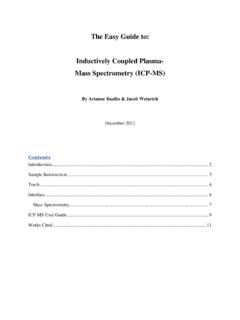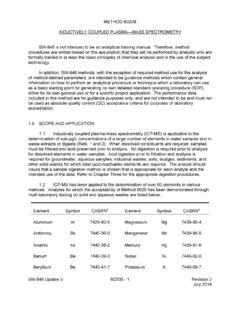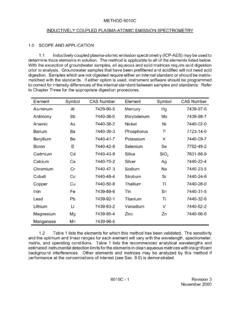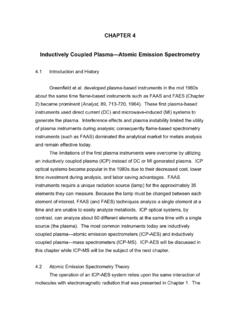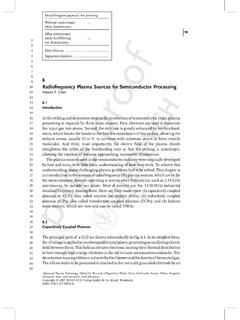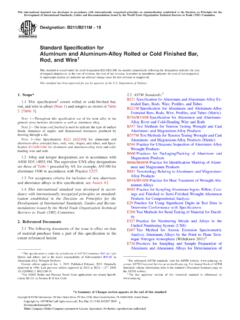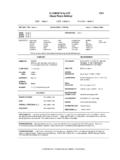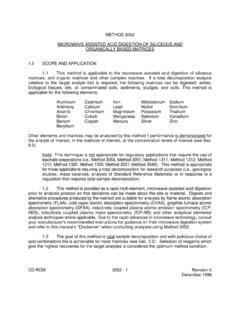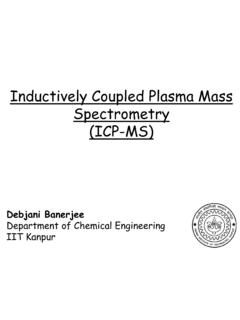Transcription of Determination of elements by ICP-AES and ICP-MS
1 1 HORIZONTAL - 19 September 2003 HORIZONTAL - 19 Determination of elements by ICP-AES and ICP-MSHenk J van de WielNational Institute of Public Health and the Environment (RIVM)Bilthoven, The Netherlands2 HORIZONTAL - 19 AcknowledgementThis work has been carried out with the financial support of the following EU member countries:UK, Germany, France, Spain, Nordic Countries,The Netherlands, Denmark, Austria, EU DG XI and JRC IspraHORIZONTAL 193 SUMMARYIn cooperation with the Dutch Standardization Institute (NEN) an inventory has been made of ex-isting standards and draft documents on the analysis of elements in relevant environmental ma-trices by inductively coupled Plasma Atomic Emission Spectrometry ( ICP-AES ) and by induc - tively coupled Plasma Mass Spectrometry ( ICP-MS ).
2 Documents have been evaluated for their applicability as a horizontal this evaluation draft horizontal standards were prepared for the Determination of:37 elements in aqueous solutions and digests of solids by ICP-AES ;66 elements in aqueous solutions and digests of solids by - 191 INTRODUCTIONThis desk study covers an investigation into the potential for horizontal standardization of meth-ods for the Determination of elements in acid digests by inductively coupled Plasma AtomicEmission Spectrometry ( ICP-AES ) and by inductively coupled Plasma Mass Spectrometry( ICP-MS ).The report contains: An evaluation of the potential for horizontal standardization based on existing standards, in-cluding the needs and material properties, identification of relevant fields and where possibleincluding waste A draft horizontal standard for the Determination by ICP-AES of trace elements in aqua regiaand nitric acid digests.
3 A draft horizontal standard for the Determination by ICP-MS of trace elements in aqua regiaand nitric acid digests. An itemized list of key point for discussion with recommended ICP-AES List of relevant ICP-AES standardsAll standards and draft standards available from ISO, CEN and NEN using ICP-AES for the de-termination of elements in environmental matrices are given below: ISO 11885:1996 Water Quality Determination of 33 elements by inductively coupled plasmaatomic emission spectroscopy NPR 6425:1995 inductively coupled plasma atomic emission spectrometry, general guide-lines (In Dutch) NEN 6426:1995 Water Determination of 40 elements by inductively coupled plasma atomicemission spectrometry (in Dutch) EPA Method 6010B:1996 inductively coupled plasma atomic emission Description of standards for trace elements by ISO 11885.
4 1996 Water Quality Determination of 33 elements by inductively cou-pled plasma atomic emission spectroscopyISO 11885 describes the Determination of dissolved, particulate and total elements in raw, pota-ble and wastewater. The 33 elements determined include all important trace elements in envi-ronmental acidified samples (nitric acid) are analyzed to give dissolved elements ; the filtrate is di-gested consecutively with nitric acid and hydrochloric acid to give particulate elements and thewhole sample is digested with nitric acid to give total elements . The standard warns that the totalelements procedure may only partially dissolve some elements like silicon, aluminum, tin, titaniumand that the digestion matrix for the three measurands is not the technique is based on the measurement of the emission at one wavelength, which is highlyselective for a specific element.
5 Calibration matrix should match as much as possible the samplematrix. In practice it means that both acid compositions are the same. If the sensitivity of the ele-ment in the sample deviates considerably from that in the calibration matrix standard additioncalibration is method does not go into detail about calibration and how to minimize 195 The standard leaves room for all types of ICP-AES instrumentation. There are no instrumentalquality of data is controlled by quality control requirements: Independent calibration solution obtained from an outside source to verify the trueness of thestandards applied (deviation less than 5%). Check standard after every 25 samples (deviation less than 5%) Inter-element and background correction check sample at the beginning, end, and at periodicintervals throughout the sample run (deviation within control limits).
6 The standard mentions typical detection limits, trueness and precision data: All trace elements have detection limits less than 0,1 mg/l. Systematic deviations are not significant. Coefficients of variation for (interlaboratory)reproducibility are less than 5% except for thealkali metals sodium, potassium, magnesium and calcium and the elements sulfur and NPR 6425:1995 inductively coupled plasma atomic emission spectrometry, generalguidelines (In Dutch)NPR 6425 is a guideline. It describes: Principles of ICP-AES analysis. Instrumentation in detail. Signal generation, sources of interferences and matrix effects. Method development: Wavelength selection, background correction, inter-element correction Optimization of measurement conditions Sample pretreatment.
7 Calibration, including standard addition calibration Analysis Validation Quality controlThe guide is meant to set up a measurement procedure. In practice it is the reference of specificmeasurement standards like NEN NEN 6426:1995 Water Determination of 40 elements by inductively coupledplasma atomic emission spectrometry (in Dutch)NEN 6426 describes the Determination of 40 elements in water, eluates and digests of water andsolids. On top of the 33 elements of ISO 11885 seven other elements can be analyzed: cerium,lanthanum, neodymium, praseodymium, samarium and technique is similar to ISO 11885. Additionally, the guide recommends measuring, if possi-ble, at two different wavelengths and using the difference of the measurement results as an indi-cator for standard requires ICP-AES instrumentation equipped with a background correction , background correction is standard refers to NPR 6425 for performance tests and performance limits.
8 The standarddoes not give instructions for quality control during a - 19 The standard mentions typical detection limits all less than 0,1 mg/l. Detection limits are achiev-able if the response is free of data on trueness and precision are EPA Method 6010B:1996 inductively coupled plasma atomic emission spectrome-tryEPA s method 6010B is applicable to 31 elements . Method 6010B mentions on top of the ISO11885 list of elements mercury and thallium, but lacks bismuth, sulfur, tungsten and is applicable to different types of water, eluates and digests of waste, soil, sludge and principle, the method is similar to ISO 11885. However, it provides extensive information on: Interference and matrix effects including quantification and correction procedures. Memory effects.
9 Setting up instrument parameters (optics, flows, data acquisition) Calibration: preparation of solutions, linear calibration functions and non-linear responsecurves obtained due to ionization and self-absorption. Quality controlMethod 6010B is open for all computer-controlled ICP-AES instruments equipped with back-ground correction. There are no specific instrumental performance of data is controlled by quality control requirements: Interference of uncorrected elements shall be less than 20% of the measured value. Change of inter-element correction shall be less than 10%. Inter-element correction is rec-ommended for all listed interfering elements that may result in a response higher than the re-porting limit. Difference between matrix spiked duplicate samples shall be within 20%.
10 Post digestion spike recovery shall be between 75% and 125% (required when a new or un-usual matrix is encountered). Difference between results for the original sample and the fivefold diluted sample shall beless than 10% (alternative test required when a new or unusual matrix is encountered). Calibration blank check shall be within 3 times the instrumental detection limit. Calibration check standard, at the beginning, end and after every 10 samples, shall be within10%. Method blank (including preparations prior to ICP-AES analysis) required. No acceptancecriteria 6010B mentions typical detection limits, trueness and precision data: All trace elements have detection limits less than 0,05 mg/l. Systematic deviations for aqueous samples are not significant (the only deviating result, 20%for selenium, was obtained from only 2 laboratories).
